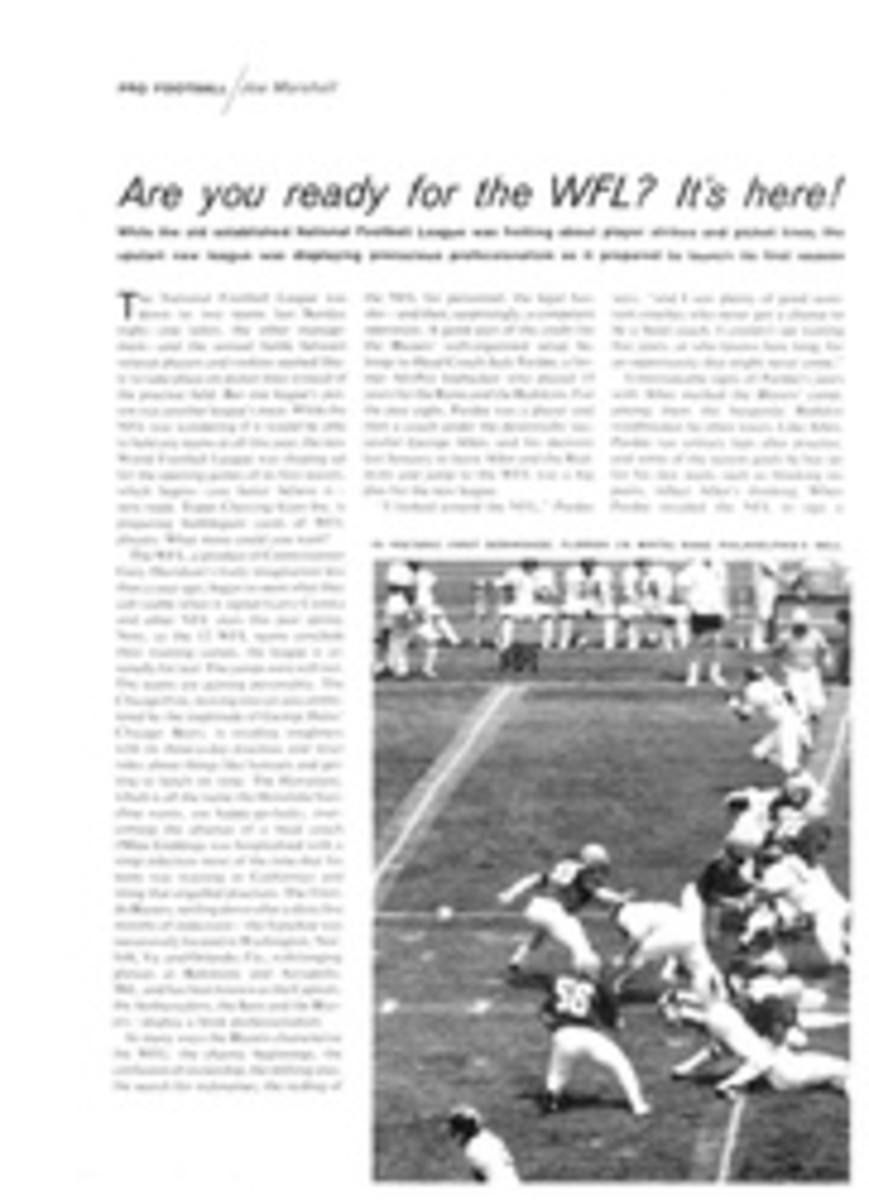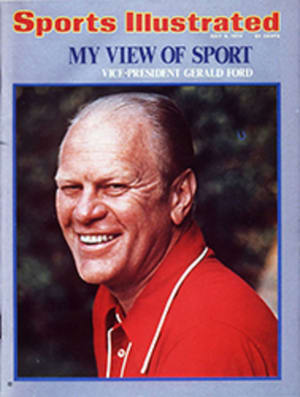
Are you ready for the WFL? It's here!
The National Football League was down to two teams last Sunday night—one labor, the other management—and the annual battle between veteran players and rookies seemed likely to take place on picket lines instead of the practice field. But one league's poison was another league's meat. While the NFL was wondering if it would be able to field any teams at all this year, the new World Football League was shaping up for the opening games of its first season, which begins—you better believe it—next week. Topps Chewing Gum Inc. is preparing bubblegum cards of WFL players. What more could you want?
The WFL, a product of Commissioner Gary Davidson's lively imagination less than a year ago, began to seem what they call viable when it signed Larry Csonka and other NFL stars this past spring. Now, as the 12 WFL teams conclude their training camps, the league is assuredly for real. The camps were well run. The teams are gaining personality. The Chicago Fire, moving into an area embittered by the ineptitude of George Halas' Chicago Bears, is exuding toughness with its three-a-day practices and strict rules about things like haircuts and getting to lunch on time. The Hawaiians, which is all the name the Honolulu franchise wants, are happy-go-lucky, overcoming the absence of a head coach (Mike Giddings was hospitalized with a strep infection most of the time that his team was training in California) and smog that engulfed practices. The Florida Blazers, settling down after a dizzy five months of indecision—the franchise was successively located in Washington, Norfolk, Va. and Orlando, Fla., with longing glances at Baltimore and Annapolis, Md., and has been known as the Capitals, the Ambassadors, the Suns and the Blazers—display a brisk professionalism.
In many ways the Blazers characterize the WFL: the chaotic beginnings, the confusion of ownership, the shifting sites, the search for nicknames, the raiding of the NFL for personnel, the legal hassles—and then, surprisingly, a competent operation. A good part of the credit for the Blazers' well-organized setup belongs to Head Coach Jack Pardee, a former All-Pro linebacker who played 15 years for the Rams and the Redskins. For the past eight, Pardee was a player and then a coach under the perennially successful George Allen, and his decision last January to leave Allen and the Redskins and jump to the WFL was a big plus for the new league.
"I looked around the NFL," Pardee says, "and I saw plenty of good assistant coaches who never got a chance to be a head coach. I couldn't see waiting five years, or who knows how long, for an opportunity that might never come."
Unmistakable signs of Pardee's years with Allen marked the Blazers' camp, among them the burgundy Redskin windbreaker he often wears. Like Allen, Pardee ran solitary laps after practice, and some of the season goals he has set for his new team, such as blocking six punts, reflect Allen's thinking. When Pardee invaded the NFL to sign a "gamebreaker," he followed Allen's emphasis on defense and came up with Bill Bergey of the Cincinnati Bengals. "He is the best middle linebacker in football," says Pardee. "He's like Dick Butkus before his legs went bad." Bergey's defection prompted the Bengals to go to court, the first legal action taken by the NFL against the new league. Bergey's move was upheld, although he must play for Cincinnati this year and next, and thus can't report to the Blazers until 1976.
Pardee is sparing with words, and his approach to his players has been low key. "I've never been real responsive to being cussed or hollered at," he says. "I've told my players I'll treat them like I'd expect to be treated. But if I can't get along with them or if they break the rules, they'll be gone." The Blazers appear to welcome this approach. Says Wide Receiver Billy Walik, who played three seasons with the Philadelphia Eagles, "If there's a face coming out of the locker room that isn't smiling, I'd like to see it."
But Pardee trained his team hard, scheduling workouts at 9:30 at night for players who needed extra conditioning. Jim Strong, a running back who played for three NFL teams, says it was the toughest camp he had ever been in. The hard labor appeared to pay off when the Blazers outclassed the Philadelphia Bell in the first WFL scrimmage ever. That was in mid-June at Shippensburg (Pa.) State College, where a local broadcaster proclaimed, "Sports history is being made right here in Shippensburg today."
Among the players Pardee is depending on this year is Defensive Back Rickie Harris, who was an NFL starter for seven years and in 1972 was named the most valuable defensive player on the New England Patriots. Then, surprisingly, he was released by the Patriots during the off-season. Tom Beer, player personnel director of the New York Stars who played with Harris on the Patriots, says, "Rickie was waived because he wasn't afraid to speak out."
Harris tried to catch on with the Minnesota Vikings last summer but was dropped after the first week. He called other teams, and says they would first express interest and then quickly lose interest. The problem apparently was a personal one. Pardee says, "He's better now than anyone New England had last year. They never replaced him."
"I just wanted someone to put me on the field and be open-minded," Harris says. "Players are fed up with the way the NFL has been treating them."
For the Blazers and other WFL clubs, a greater problem than finding players was the matter of obtaining sufficient financial backing to withstand the losses anticipated for the first few years of operation. Season-ticket sales are said to be near 20,000 in Southern California and Jacksonville, and near 15,000 in Honolulu and Chicago. Of course, they were reported near 20,000 in Birmingham until a plea for new investors revealed that only 7,200 had been sold. That caused some adverse reaction. Head Coach Jack Gotta said angrily, "All I know is what I read in the papers. I told a civic club in Birmingham we'd sold 20,000 tickets. This makes me look like a jackass. Publicity gimmicks are one thing, but deceit is another."
Nonetheless, the Americans, who play in Birmingham, a football hotbed, are expected to do well at the gate. Such promise of things to come is the base on which Davidson organized the WFL, and the Blazers again are a prime example of the technique of creating something financially valuable out of nothing. On Jan. 14 Davidson awarded what was then called the Washington-Baltimore franchise to E. Joseph Wheeler Jr. for a fee estimated at a quarter of a million dollars. Wheeler, a 48-year-old president of an oceanographic engineering firm who calls himself a "Wheeler-doer," said he had backers, but apparently the backers were interested in putting up hard cash only if Wheeler's new team could play in Washington's R.F.K. Stadium. But the rival Redskins had an exclusive lease at R.F.K. Wheeler, who at first said his team would play its home games in Annapolis, 40 miles from Washington, talked of large fees he would pay the Redskins to let him share the stadium. "He offered me a corporate note on a company called the Washington Capitals, Inc.," says Edward Bennett Williams, president of the Redskins. "He never even showed me the first dollar."
"We don't want to compete head on or detract from the Redskins or the Baltimore Colts," said Wheeler. "I'm not coming in to start a raid on the Redskins or the Colts." So saying, he plucked Pardee from Allen's staff, and Pardee promptly drafted seven Redskins (none of whom chose to join the new team).
Wheeler's credibility faded. He forgot about Washington and Annapolis and moved his base to Norfolk, saying he was there to stay. "He lacked only one thing: money," says George Robert House, Norfolk city manager.
Wheeler and his wanderers looked lost and the entire WFL began to look shaky. Other WFL teams were roaming about, too. Toronto, which pulled off the Csonka coup, eventually wound up in Memphis, while the original New York franchise switched to Portland, Ore. and the original Boston franchise to New York. To Wheeler's rescue came Rommie Loudd, a former linebacker and personnel director for the Patriots who had spent years trying to land an NFL franchise for a group of Orlando investors. "I was pushing interracial ownership," says Loudd, who is black. "The NFL still does not have any black owners or general managers. Management is all white while 40% of the players are black."
Despairing of his chances of getting an NFL franchise (the current fee is $16 million), Loudd wired Davidson who brought Wheeler and Loudd's group together. Within a month the Orlando people purchased the tottering franchise and put it on its feet in Orlando. This left Wheeler with a big smile and, he claims, "a very favorable return." He says the sale price was $3.2 million; Loudd says it was about half that much, and part of that amount was to cover outstanding bills. How big a profit Wheeler actually turned is debatable, but the very fact that he came out of the mess smiling enhanced the credibility of Davidson and his league.
Although he is no longer part of the WFL, Wheeler still sounds like an evangelist when he talks about it. "On Jan. 14," he says, "I evaluated Gary Davidson as a doer, and on July 10 my evaluation is going to come true. That is the day 10 World Football League teams are going to play football, and on July 11 two more are going to be on national TV. It would take an act of God to stop the WFL now."
PHOTO
IN HISTORIC FIRST SCRIMMAGE, FLORIDA (IN WHITE) RANG PHILADELPHIA'S BELL
TWO PHOTOS
NFL REBEL RICKIE HARRIS EARNED PRAISE AND A JOB FROM BLAZER COACH PARDEE

